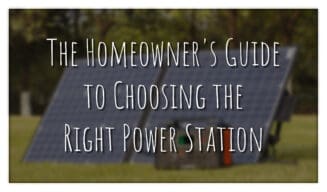
The Homeowner’s Guide to Choosing the Right Power Station
A portable power station is an affordable alternative to a generator. It can be a vital asset when it comes to ensuring that your home has a reliable power source, especially in the face of outages or while camping off-grid. It’s a device that stores electrical energy for later use and can be charged from various sources, including wall outlets, car chargers, and solar panels. But with so many options on the market, how do you choose the right one for your home? Let’s break down the process into manageable steps.
Understanding Power Stations
First, it’s important to understand what a power station is. Unlike a generator that creates electricity by burning fuel, a power station stores electricity in a battery that can be used when needed. It’s essentially a large battery with multiple outlets – USB for smartphones and tablets, DC for refrigerators, and AC for household appliances.
Power Station Expansion Batteries and Solar Panels
Some power stations can be expanded with additional batteries, effectively increasing their capacity. This is particularly useful if you find that your power needs grow over time. Expansion batteries are an added investment but can be invaluable for those requiring more robust energy solutions.
Solar panels offer the benefit of renewable energy charging. They convert sunlight into electrical energy, providing an eco-friendly way to keep your power station charged. When opting for solar panels, consider their wattage and the charging speed for your power station. A higher wattage panel will charge your station faster, given sufficient sunlight.
Calculating Power Needs
Before choosing a power station, you must determine your power needs. This means figuring out what devices you’ll want to run and for how long. It would be best to prioritize which devices to use in the event of a power outage. For example, you may need to ensure the refrigerator is running, while powering a TV might not be necessary. Here’s a simple way to calculate your power needs:
1. List Your Devices: Write down all the devices you want to power. This could include laptops, phones, lamps, fans, small refrigerators, or medical devices.
2. Check the Wattage: Look for the wattage of each device, usually found on the device itself or in the user manual. The wattage tells you how much power the device consumes per hour.
3. Estimate Usage Time: Decide how many hours you’ll likely use each device between power station charges.
4. Do the Math: Multiply the wattage of each device by the number of hours you plan to use it. This gives you the watt-hours (Wh) for each device. Add up all the watt-hours to find your total power needs.
For example, if you have a lamp that uses 10 watts and you want to run it for 5 hours, that’s 10 watts x 5 hours = 50 Wh.
Choosing the Right-Sized Power Station
With your total power needs calculated, you can now look for a power station with a little more capacity than your calculated watt-hours. This extra capacity acts as a buffer to ensure you don’t run out of power unexpectedly.
Peak Power
Understanding the peak power of a power station is crucial when selecting the right one for your home. Peak power refers to the maximum amount of power that the station can supply at once, albeit for a brief moment. Most electrical devices draw more power when they first start up – this is known as the “starting load” or “surge power.” For instance, a refrigerator might need a surge of power to start the compressor, exceeding its running wattage. If your power station cannot handle this initial surge, the device may not start at all, or it could potentially damage the device.
Therefore, when reviewing the specifications of a power station, it’s essential to compare the peak power rating with the highest surge power demand of your appliances. If the peak power rating of the power station is too low, it won’t be able to handle the initial power surge from high-demand devices. To ensure reliability and prevent overload, choose a unit with a peak power rating exceeding the highest starting load you expect to encounter in your home devices. This foresight will ensure that your devices operate smoothly and the power station can deliver the necessary energy when it’s most needed.
Other Considerations When Choosing a Power Station
– Portability: Think about how you’ll use the power station. If you plan to take it camping or use it in various places around the home, you might want a lighter, more portable model.
– Outlets: Ensure the power station has the right type and number of outlets for your devices.
– Recharging Time: Consider how long it takes for the power station to recharge and how you will recharge it. If you’re relying on solar panels, remember that recharging is dependent on sunlight availability.
– Budget: Power stations come in a wide range of prices. Higher capacity and more features typically mean a higher price, so balance your needs with what you’re willing to spend.
– Brand Reputation and Warranty: Choose a manufacturer with a good reputation for quality and service. Also, check the warranty and what it covers.
Conclusion
A power station can be a lifeline during power outages or when living off-grid. By understanding your power needs, considering the possibility of expansion batteries, and the eco-friendly option of solar panel charging, you can select a power system that best suits your home’s needs. Remember to account for all your devices, calculate the total watt-hours required, and choose a power station with a capacity that meets or exceeds that number. With the right preparation, your home will have a dependable power source for any situation.
For more homeowner tips, check out our blog.
Back to Blog